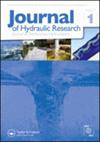由于岩石位移引起的堰岩破坏
IF 1.7
3区 工程技术
Q3 ENGINEERING, CIVIL
引用次数: 0
摘要
石堰是低水头河流修复结构。本研究包括两组水槽试验(即固定床和活动砂床试验),以研究岩石移位过程,这是岩石堰失效的主要原因。分析和讨论了引流强度、淹没度、孔隙比和河床泥沙冲刷对岩堰位移的影响,以及岩堰泥沙冲刷对石堰位移的响应。定义了三个界限来对岩石堰的位移量进行分类:(1)界限I表示岩石从下游堰趾的初始位移;(2) 极限II表明有少量岩石从下游堰面和堰顶脱落;(3) 极限III表明,大量岩石从下游堰面和堰顶脱落,导致堰失效。针对岩石堰的设计,提出了每个极限的预测值。本文章由计算机程序翻译,如有差异,请以英文原文为准。
Failure of rock weirs due to rock dislodgements
Rock weirs are low-head river restoration structures. The present study comprised two sets of flume tests (i.e. fixed bed and moveable sand bed tests) to investigate the rock dislodgement process, which is a primary cause of the failure of rock weirs. The impacts of approach flow intensity, submergence, void ratio and scour of bed sediment on rock weir dislodgement, and the responses of sediment bed scour at rock weirs to the rock weir dislodgement, are analysed and discussed. Three limits are defined to classify the amount of the rock weir dislodgement: (1) limit I indicates the incipient dislodgement of rock from downstream weir toe; (2) limit II indicates that a few rocks are dislodged from downstream weir face and weir crest; (3) limit III indicates that large numbers of rocks are dislodged from downstream weir face and weir crest, which leads to weir failure. A predictor of each limit is proposed for rock weir design.
求助全文
通过发布文献求助,成功后即可免费获取论文全文。
去求助
来源期刊

Journal of Hydraulic Research
工程技术-工程:土木
CiteScore
4.90
自引率
4.30%
发文量
55
审稿时长
6.6 months
期刊介绍:
The Journal of Hydraulic Research (JHR) is the flagship journal of the International Association for Hydro-Environment Engineering and Research (IAHR). It publishes research papers in theoretical, experimental and computational hydraulics and fluid mechanics, particularly relating to rivers, lakes, estuaries, coasts, constructed waterways, and some internal flows such as pipe flows. To reflect current tendencies in water research, outcomes of interdisciplinary hydro-environment studies with a strong fluid mechanical component are especially invited. Although the preference is given to the fundamental issues, the papers focusing on important unconventional or emerging applications of broad interest are also welcome.
 求助内容:
求助内容: 应助结果提醒方式:
应助结果提醒方式:


